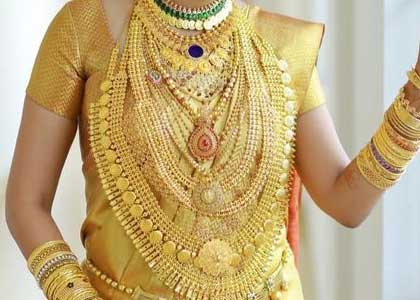Dress and Ornaments
In the matter of dress and ornaments, Kerala presents through the age a picture of astonishing variety. Simplicity and elegance of dress is a trait of the Malayali character. The common male dress is the white 'mundu' or cloth which is worn around the waist. A small upper garment ie. 'Neryahu' is also worn over the shoulder.
The women of several castes and communities have their distinctive forms of dress. The Hindu and Christian women have generally preferred white clothes. A jacket is worn over the upper part of the body. The Muslim women wear a cloth called 'Kacha mundu' or a coloured cloth, a white loose jacket and a scarf on the head. The 'purdah' system is still prevalent among the most orthodox Muslim women in some parts of north Kerala.
Ornaments of different patterns are used by women of all communities and castes. These ornaments are for the neck, the arm, the nose, and the ankle. The oldest ornament of the 'Nair' women for the neck was the serpent's hood, so called after the shape of the pendant. Among other necklaces were 'nalupanti', 'addiyar', 'puthali', 'avil mala', 'patakkam' etc. The ornaments for the nose were 'mukkuthi' and 'nattu'. The 'Namboothiri' women do not wear costly ornaments. The 'Kaasumala' and the 'oddyanam' were the most characteristic of their ornaments.

The traditional Christian women bore their ear in several places and wear a heavy gilt brass ring called `mekkamotiram' at the top of each ear. The ornaments common among them were the `patakkamala', `the vala', `elas', `aranjanam', rings on the ten fingers etc.
The Muslim women wore an incredibly large number of ornaments. They had five or six ornaments each on the neck like `puthali', `effakkathali' etc. and for the waist the `arapatta' in addition to ankles, bracelets and bangles. As many as fourteen holes were sometimes bored in each ear lobe and a long string of ornaments was suspended through it.
In modern times there has been a change in the attitude of people towards the use of ornaments. The present tendency is to limit the number of ornaments to the absolute minimum. Women take special care in the growth and preservation of the hair. They use plenty of oil to improve its growth and keep it smooth and shining. The Kerala women apply the 'kumkum' or 'pottu' on their forehead. At one time it was done only by the Hindus and hence it was considered a caste mark. But in recent times young women of all castes and communities prefer this and what was once a caste mark has been transformed into a beauty mark.




